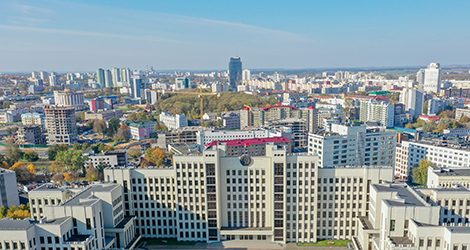The economic background of Belarus

Belarusian economy: Figures and facts, attractiveness of the country as a trading partner
Economy
The Belarusian economy is export-oriented, with well-developed manufacturing sector, services and agriculture industries.
The economy of Belarus has seen sustained growth in recent years.
Facts and figures:
-
steady increase in GDP since 1992
-
considerable reduction in the trade deficit
-
improvement in the standard of living for the population of Belarus
The GDP of Belarus exceeded $72 billion in 2023. In U.S. dollar terms, it expanded 4.1 times over 1993.
In terms of purchasing power parity per capita, GDP rose 6.5 times over 30 years - up to $30,800.
The gold and foreign exchange reserves have increased 17 times over the last 20 years.
The debt burden on the economy is steadily decreasing: gross external debt relative to GDP has decreased to 50.5% (as of 1 July 2024), which is significantly less than the world indicator.
Business and individual have access to credits: in 2024 the refinancing rate was 9.5% per annum (480% in 1994)
Real money incomes of the population have grown 4.7 times over 30 years, real wages - 6.6 times.
Belarus has one of the lowest levels of poverty - 3.6% (more than 38% of the population was below the poverty line in the mid-1990s).
The inflation rate in the country does not exceed 6% (hyperinflation in the 1990s, with the consumer price index exceeding 2000% in 1993).
How has the global credit crisis affected Belarus?
Belarus today pursues a socially-oriented market economy model.
Whilst the state’s involvement in business and banks in Belarus and its control of fiscal and monetary policies have been criticized by some, Belarus’ independence from global markets has shown it has not been as badly affected by the global credit crisis as many other countries.
Many of Belarus’ major trading partners have been affected by the crisis and this has had an impact on the country’s economic growth. However, global market analysts predict an early recovery and positive economic future for the Belarus.
What makes Belarus trade friendly?
The Belarusian economy is just one reason why the country is so attractive for international trade. Here are some other factors:
-
geographical location
-
favorable investment climate
-
highly skilled workforce
-
industrially developed economy
-
well-developed transport and communications infrastructure
Belarus maintains trade relations with most countries of the world. In 2023, Belarus traded with over 200 countries and exported its goods to 157 countries.
Belarus is one of the major food exporters in the world. It is among the top five exporters of dairy products and the top 15 exporters of meat products.
Read more about the benefits of trading with Belarus
Belarus and the World Trade Organization (WTO)
Belarus applied to join the WTO back in 1993. Negotiations were held for many years. The country worked hard to meet the requirements of the organization.
Work on Belarus' WTO accession process was halted after sanctions were imposed on the country in 2020-2021. In March 2022, the WTO announced that it would not consider Belarus's application, thus ending a long period of work and nullifying the efforts of numerous diplomats to engage the country in international integration processes.








 print version
print version make home page
make home page add to bookmarks
add to bookmarks



